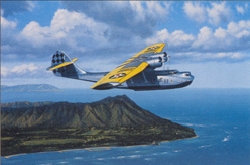|
|
| Wings Over Waikiki |
|
 |

|
 |
|
|
| DESCRIPTION |
 |
| 16 x 11.5 Inch Collector Size Unframed Lithograph $40.00
The Consolidated PBY Catalina the sea going flying workhorse of the US Navy during WW II is with no doubt the most successful flying boat ever produced. Produced for more than ten years it was built in greater numbers (3300) than any other flying boat in history. In the early days of aviation flying boats made a lot of sense because of the relatively limited number of prepared airfields. Any estuary river or lake could become an airfield for an aircraft designed as a flying boat. Consolidated Aircraft got into the flying boat business rather late in the game. In 1928 the company won a bid to produce a prototype of a new high-wing monoplane flying boat for the Navy which would utilize aluminum in its fabrication. The XPY prototype was successfully flown in early 1929 but the Glen L. Martin Co. one of the pioneers in flying boat production won the production contract. Not deterred by this setback Consolidated utilized the expertise it had developed on this project to introduce a commercial 28-passenger flying boat called the "Commodore." This aircraft was utilized by a number of airlines including Pan Am. Concurrent with work on the Commodore the Consolidated design team set about developing an improved version of the XPY. This design (the P2Y-1) had an enclosed cockpit and was designed to handle either two or three engines. A total of 47 P2Ys were put in service. As production commenced on the P2Y Consolidated began work on another improved flying boat which would be considerably larger than the P2Y. The prototype of this new aircraft (the XPY-3) utilized retractable wing floats. In 1935 Consolidated won the initial production order for the first PBY-1s in 1935. In 1936 another fifty aircraft were ordered as the PBY-2 derivative. A PBY-2 based in Hawaii is depicted in its pre-war markings over Diamond Head in Stan Stokes painting entitled Wings Over Waikiki. This version lacked the fuselage window blisters which would be used on later variants. The PBY-2 had a wing span of 104 feet and was nearly 64 feet in length. Powered by two 850-HP Pratt and Whitney R-1830-64s the PBY-2 had a maximum speed of 178-MPH and a range of more than 2000 miles. The British ordered more than 100 PBYs in 1939. They called the aircraft "Catalina." Also in 1939 a number of Catalinas were modified into amphibians by adding a retractable tricycle undercarriage. This added more than 2000 pounds to the weight of the aircraft but also improved its versatility. In the first few days following the Japanese attack on Pearl Harbor many of the PBYs deployed throughout the Pacific were damaged or destroyed. The PBYs were vulnerable to enemy fighter attack when in the air. Despite these early setbacks the Navy learned to make good use of the PBY as the war progressed. One of the most effective uses of the aircraft was in night search and attack missions where the aircraft were generally painted all black. These "Black Cats" operated from island bases and seaplane tenders and effectively hampered night time movement of enemy supplies. The Catalina also flew many "Dumbo" missions during the war rescuing downed allied aviators. Many thousands of lives were saved during these missions. |
|


|